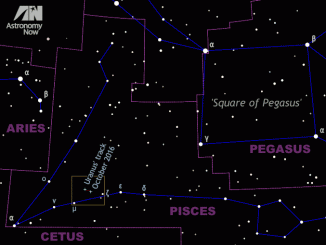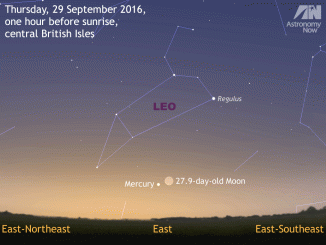
Articles by Ade Ashford


Halloween near-Earth asteroid 2003 YT1 has Polaris encounter on 2 November
At 9:24am GMT on 31 October 2016, near-Earth asteroid 164121 (2003 YT1) will safely fly by at a distance of 3.2 million miles (5.2 million kilometres), or 13.5 times the distance of the Moon. Furthermore, this 1.1-mile-(1.7-kilometre)-wide Apollo asteroid also passes very close to Polaris early on 2 November, creating a rare astrophotographic and observing opportunity.

See the old crescent Moon close to Jupiter in the morning sky
UK observers with a clear sky an hour before sunrise on Friday 28 October should look very low in the east-southeast to see the slim crescent of the 27-day-old Moon less than four lunar diameters away from largest planet Jupiter. The Moon and Jupiter are also joined by third-magnitude double star gamma (γ) Virginis, commonly known as Porrima.

How to find Ceres, the nearest and brightest dwarf planet at its best
Ceres, the largest minor planet inside the orbit of Neptune, passed closest to Earth on the evening of 22 October — the night of the last quarter Moon. With the lunar crescent now confined to the morning sky, grab your binoculars or telescope, print out some star charts from our online guide and track down the brightest of the dwarf planets while at its best.

See planet Uranus at its best in the autumn sky
Have you ever seen Uranus with the naked eye? If not, moonless nights in October offer ideal conditions to test your visual acuity and sky clarity. Uranus reaches opposition on 15 October and attains a respectable altitude in the southern sky as seen from the British Isles. Here is our guide to tracking down the seventh planet from the Sun.

See Mercury at its best in the east at dawn
Mercury is currently putting on a fine show in the east before dawn. Find a UK location with an unobstructed view due east an hour before sunrise to see the innermost planet some 6 degrees above the horizon from about 25 September—5 October. The very old crescent Moon lies just 2 degrees from Mercury at dawn on Thursday, 29 September.

See the Moon hide planet Neptune on 15 September
Observers up for an extreme observing challenge may care to make an attempt at viewing the almost full Moon pass in front of planet Neptune soon after 8pm BST on Thursday, 15 September. The planet’s disappearance occurs at a low altitude in twilight for the British Isles, but can also be seen from a large swathe of Europe and western Russia.

See the Moon meet Saturn and Mars in the evening sky
A hundred days have passed since Mars was closest to Earth this year, but the Red Planet can still be seen in the early evening sky close to the jewel of the solar system, Saturn. If you wish to identify this pair of planets, then a convenient celestial marker in the form of the waxing crescent Moon passes by on the evenings of 8—9 September in the UK and Western Europe.


